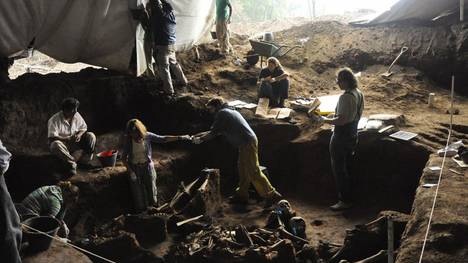
Argentine forensic scientists unearth a mass grave at a military garrison which gained infamy during the junta dictatorship of the 1970s and early ’80s. Here’s a rundown of what they found in it, courtesy of Cubadebate:
A mass grave with remains of disappeared persons from the time of the dictatorship was discovered in the former Miguel de Azcuénaga Arsenal, which served as the largest clandestine detention and extermination centre in Tucumán province, Argentina.
Judicial sources revealed the finding within hours of confirmation that in the Pozo de Vargas, remains were identified as those of former senator Guillermo Vargas Aignasse, who in April, 1976.
The excavation, conducted in the barracks courtyard, revealed “calcined bone remains”, as well as “entire bodies in different positions, many with upper extremities bound, some with projectiles and directly associated shells nearby.”
Specialists from the Argentine Forensic Anthropology Team (EAAF), in collaboration with the Interdisciplinary Archeology and Anthropology of Tucumán, revealed this finding in relation to case 400443/84, according to the website of the Centre for Judicial Information.
“The found bodies were located as they had fallen,” said a source, estimating that “the gravesite had been burned”, as there were “tire tubes and marks of combustion on the bodies.”
At the moment, according to information from Federal Court #2, under the auspices of judge Raúl Daniel Bejas, there were “skeletal remains of a minimum of 15 individuals, partially burned”, along with “elements associated with those remains, such as firearms projectiles, remains of clothing, and footwear.”
The gravesite also “showed signs of a backhoe…supporting the hypothesis that at first, a burning of the bodies took place, then later the filling of the grave using a backhoe, in order to finally cover it over.” This reinforces the presumption of aggravated homicide and “actions after the fact, aimed at guaranteeing impunity for crimes committed.”
After 1975, during the so-called “Operation Independence” and the dictatorship, the arsenal served as a concentration and death camp copied from those constructed by the Nazis during the Third Reich, with barracks for prisoners, a double perimeter fence, and guard towers.
Translation mine.
The other day, I was watching Nuestros Desaparecidos again, for the umpteenth time. I cry pretty much all the way through, but what gets me most is what they chant at the end as they march through the streets:
¡Ahora! ¡Ahora! ¡Resulta indispensable! ¡Aparición con vida, y castigo a los culpables! (“Now! Now! It’s indispensable! They [the disappeared] must appear alive, and the guilty be punished!”)
The dead won’t reappear alive, sadly…but that doesn’t mean they can’t tell some mighty damning tales. Let us now hope that at least a few more of the guilty will face justice for this.
